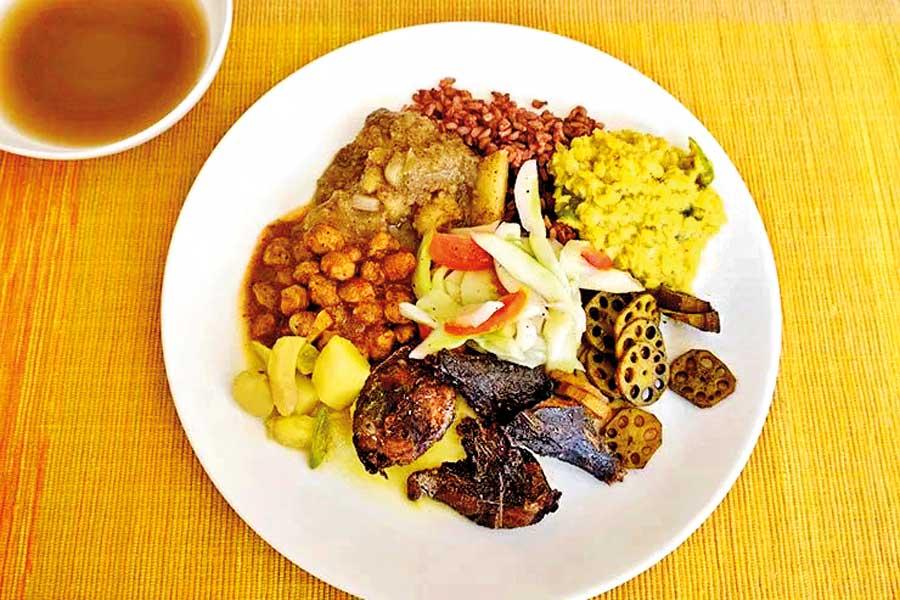04 Aug 2021 - {{hitsCtrl.values.hits}}

For the control and prevention of Madhumeha (Type - 2 Diabetes) healthy food patterns are important
- Food which is essential for the sustenance of life can become a cause for some diseases if used in an improper way
- Fruits and vegetables are low in fat, salt, sugar and they are a good source of dietary fibers
A non-communicable disease (NCD) is a disease that is not transmissible directly from one person to another. These are the result of a combination of genetic, physiological, environmental and behavioral factors.
These are the result of a combination of genetic, physiological, environmental and behavioral factors.
NCDs are also known as chronic diseases with long duration and said to kill 41 million people each year, equivalent to 71% of all deaths globally. 85% of these “premature” deaths occur in low- and middle-income countries. NCDs include Diabetes mellitus (DM), Hypertension (HT), Parkinson’s disease, Strokes, Heart diseases, Cancers, Chronic Kidney Diseases (CKD) and others. Treatment modalities take a long time to cure these diseases and some of them are not curable.
Therefore an important way to control NCDs is to focus on reducing the risk factors associated with these diseases. Other than the medicines, mental status, behavioral and food patterns are also important in controlling and preventing from Non-Communicable Diseases.
Diabetes mellitus is one of the main NCDs which gives major long-term implications for individuals suffering from the disease as well as the health-care system as a whole. This disease is characterized by elevated blood glucose levels higher than the normal reference ranges. Diabetes mellitus has 2 types as Type 1 and Type 2 Diabetes. Type 1 or the Insulin dependent Diabetes/Juvenile Diabetes is a genetic disease and Type 2 Diabetes is mainly caused due to sedentary life style and bad food patterns. Diabetic neuropathy, Diabetic nephropathy, Diabetic retinopathy are few major complications of this chronic non-communicable disease. Resistance to Insulin hormone which helps in balancing the blood glucose level is the main cause for this disease. Signs and symptoms are increased urination, increased thirst, increased hunger, weight loss, blurred vision, excessive sleepiness. This chronic disease is diagnosed by analyzing signs, symptoms, clinical examination of the patient along with the results of investigations such as FBS, PPBS, RBS, HbA1C to check blood sugar level.
Ayurveda is one of the oldest holistic healing systems in world. Ayurveda means the “knowledge” or “the science of life”. Ayurveda connects physical, spiritual and mental processes to promote a healthy relationship between the mind, body, and soul. The primary goal of Ayurveda is to maintain healthiness by being free from diseases and providing treatment modalities for the diseased. Each living being has a tendency toward disequilibrium of certain dōshas structurally or physiologically and such imbalances may lead to disease.
According to Ayurveda disease that causes excessive urination is known as Pramēha [“mēhathi mūthrayathi ithyārtha:”]. There are 20 Pramēha rōgās mentioned in Ayurveda. Pramēha rōga that is present for a long time without treatment can transform in to the disease stage called Madhumeha. Disease where the sweetness is present in urine and body fluids like sweat, mucus is known as Madhumeha and this can be correlated with Diabetes mellitus. Madhumeha is caused by intake of kapha vitiating food like curd, jaggery, river fish, excessive intake of cow’s milk and inappropriate behaviors like physical inactivity, excessive sleep. According to Ayurveda this is one of the diseases that cannot be completely cured.
Unwholesome food in inappropriate quantity and untimely usage can lead to diseases or can aggravate already present disease conditions. Food which is essential for the sustenance of life can become a cause for some diseases if used in an improper way such as excess usage, mal usage and reduced usage. Ayurveda has given supreme importance to food we take and food is known as the best medicine (Mahaa bhesaja) among all the other medications. A balanced diet mentioned in Ayurveda has 10 components such as Shashtika, Shāli, Amla, Saindhva.
For the control and prevention of Madhumeha (Type - 2 Diabetes) healthy food patterns are important. According to modern medicine, they have mentioned about the importance of consuming food articles with low glycemic index for the control of Type - 2 Diabetes. Intake of starchy food is bad for the patients with Diabetes. As Sri Lankans Rice is the main food we take for most of our main meals. Raktha shāli (Red/Brown rice) is the best type of rice that is mentioned in Shūka category (corns with bristles) of 12 food types mentioned in Ayurveda. Traditional rice varieties like Suwadal, Kalu hēnati, Rathu hēnati, Kuruluthuda also have low glycemic index and helps in reducing blood glucose levels. According to Ayurveda, pulses are collectively known as Shami dhānya. Whole grains like green gram (Phaseolus radiata), Kavupi (Vigna unguiculate), Black gram (Vigna mungo) [Undu / Māsha] and lentils like Dhal/Parippu (Lens culinaris) are also effective in supplying energy to body with reduced glycemic index.
Fruits and vegetables are low in fat, salt, sugar and they are a good source of dietary fibers. These contain many vitamins like vitamin A (beta-carotene), C, E, minerals such as Mg, Zn, P and folic acid which are good for health. Intake of fruits and vegetables can reduce the risk of Type 2 Diabetes mellitus and other NCDs like Hypertension, Heart disease, Cancers.
Karavila / Bitter gourd (Mormodica charantia) is a cuisine commonly used in South-East Asian countries and consumed by cooking in the green or early yellowing stage.
Thembu (Costus speciosus) is a rhizomatous herb and leaves are prepared as curry or salads. This is said to be having anti-diabetic properties by stimulating β-cells in the pancreatic islets to release insulin, increasing the quantity of insulin receptors and fighting against free radicals by behaving as antioxidants and thereby, decreasing cell damage.
Kowakka (Coccinia grandis) is a perennial climber with single tendrils and glabrous leaves. This is claimed to be helpful in regulating blood sugar levels. Some researches support that compounds in this plant inhibit glucose-6-phosphatase, which is one of the key liver enzymes involved in regulating sugar metabolism. Green beans/ Bonchi (Phaseolus vulgaris) is a vegetable with many dietary fibers with low calories and contain no saturated fat. Dambala /Winged bean (Psophocarpus tetragonolobus) is rich not only with protein, but in tocopherols (antioxidants that facilitate vitamin A utilization in the body). Pathōla/Snake gourd (Trichosanthes cucumerina) is mentioned in Ayurveda as a vegetable with laghu guna (lightness) that helps in giving strength and energy. This is a vegetable with low carbohydrates similar to Wetakolu/Ridged gourd (Luffa acutangular). Both these vegetables help in increasing Insulin level and helps in maintaining blood glucose level in balanced state.
Amla/ Nelli (Phyllanthus emblica) is a fruit with many nutritional properties and this is one of the three ingredients mentioned in Triphala in Ayurveda. Triphala is included in many drug recipes. Star fruit/ Kaamarankaa (Averrhoa carambola) contains various essential nutrients including fiber, potassium, vitamin C, vitamin B5, folate and a small amount of protein. This fruit is also low in calories which supports weight loss. Lime (Citrus aurentifolia) is an acidic fruit with Vitamin C. This is rich with antioxidants such as flavonoids as well. Limes have a low glycemic index and help to regulate the way your body absorbs sugar into the bloodstream and helps in controlling blood sugar levels. Yellow vine/ Wenivelgata (Coscinium fenestratum) is a herbal drug which is used by Sri Lankans for curing body aches and pains very frequently. This is with bitter, astringent taste and light (laghu), rough (ruksha) properties.
Turmeric/ Kaha (Curcuma longa) which is used in cooking is said to be having many medicinal benefits including immune enhancing properties and strengthening the overall energy of the body. This culinary spice has digestive properties and used as a coloring agent as well. Turmeric which is known as Haridrā or Nishā is one of the commonly used medicinal drugs used in Ayurveda drug recipes prescribed for treating Madhumeha.
Ayurveda Dina charyā (daily routine) has highlighted the importance of proper exercises such as yōga to maintain healthy life. Vyāyāma (Exercises/ activities that need physical effort) like walking, running, swimming (against the water flow) has been specially mentioned for Madhumeha patients in Ayurveda. Other than these awakening in morning (Brahma muhurtha), adequate sleep at night, avoiding day sleep, sufficient intake of water, avoid alcohol usage, meditation, spiritual and mental relaxing activities are also advisable to maintain a healthy life style. By following healthy behavioral patterns and adding these important food varieties with health benefits will be helpful in preventing and controlling from this dangerous non-communicable disease.

Ayurveda Dina charya (daily routine) has highlighted the importance of proper exercises such as yoga
15 Nov 2024 20 minute ago
15 Nov 2024 22 minute ago
15 Nov 2024 34 minute ago
15 Nov 2024 1 hours ago
15 Nov 2024 2 hours ago